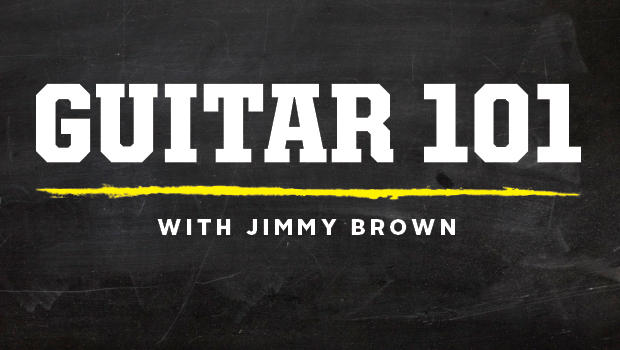Guitar 101: Mastering Rhythm and Syncopation, Part 1 — Whole, Half, Quarter and Eighth Notes

Every musician should have a clear understanding of the fundamentals of rhythm. Even if you consider yourself an “ear player,” knowing how to count and play different rhythms while keeping a steady beat is a valuable skill that will help you in a variety of real-life musical situations. By learning the arithmetic of rhythm on paper, you’ll be able to accurately read and learn music from transcriptions, and you will no longer have to rely entirely on the recording for the timing and phrasing of the notes. Just as important, you’ll be able to communicate with other musicians and bandmates, and make rehearsals and performances go more smoothly. Knowing how to count different rhythms can also help you master the complexities of today’s popular musical styles and become a more inventive songwriter and composer.
This month I’d like to begin a series of lessons on rhythm that will help you become a more competent and confident musician. We’ll start by reviewing the basic rudiments of rhythmic notation and learning how to count and play standard rhythmic patterns.
In music transcriptions, a staff is divided into measures via barlines, as depicted in FIGURE 1. Each measure typically contains four beats, as indicated by the 4/4 time signature. Counting “one two three four, one two three four,” etc. enables us to keep track of the individual beats and measures; it also provides us with a clear reference point for organizing rhythm.
A measure of 4/4 time can contain one whole note, two half notes, four quarter notes or any combination of quarter notes and half notes that adds up to four beats (see FIGURE 2).
By subdividing each beat in half and counting “one-and two-and three-and four-and, one-and two-and three-and four-and,” etc., we can divide a measure of 4/4 time into eight eighth notes, as shown in FIGURE 3. Think of a measure of 4/4 as a pizza pie—you can cut it into two halves, four quarters, eighth eighths, or any other combination of fractions that adds up to one.
Eighth notes are often used in combination with other rhythmic values to create an interesting phrasing device known as syncopation. Syncopation means emphasizing the “weak” parts of the beat or measure—anything other than 1, 2, 3 or 4.
FIGURE 4 is an example of syncopation using ties to accent the eighth-note upbeats. A tie is a curved line arcing between two notes of the same pitch. The first note is held for the combined rhythmic values (durations) of both notes. The second note is not articulated. We use a broken arc in our notation system to distinguish ties from slurs (hammer-ons, pull-offs and legato slides).
When playing FIGURES 3 and 4, be sure to tap your foot only on the downbeats (1 2 3 4) and not on the eighth-note upbeats (the “and” counts between the beats, as indicated below the staff). This is an important motor skill for reading and playing music well and requires good hand-foot-brain coordination. Make this a habit until it becomes second nature, and make sure your foot doesn’t start following your mouth or hands. Train your foot to be a living metronome.
I’ve included counting, foot tapping and picking prompts with these exercises to guide you. Proceed slowly until you’ve acquired the coordination necessary to count, tap your foot and play the rhythms correctly. Notice that the “and” counts are omitted whenever the beat isn’t subdivided.
Several of you have written in asking what a grace note is, so I’d like to end this month’s lesson with a brief explanation and example. A grace note is a quick, subtle embellishment or “decoration” of a note, such as a hammer-on, pull-off, slide or bend. In fact, it’s so quick that it is not counted as being part of the rhythm of the measure. A grace note theoretically occurs “by grace of” the preceding or following beat and is written as a small note (or tab number) that’s squeezed into the measure just to the left of the main note it decorates, as illustrated in FIGURE 5. In this example, the grace notes are placed directly over the beat, because they’re played on the beat, which is usually the case.
Next time we’ll cover dotted rhythms and rests and learn how to count and play 16th notes. See you then.
Get The Pick Newsletter
All the latest guitar news, interviews, lessons, reviews, deals and more, direct to your inbox!
Over the past 30 years, Jimmy Brown has built a reputation as one of the world's finest music educators, through his work as a transcriber and Senior Music Editor for Guitar World magazine and Lessons Editor for its sister publication, Guitar Player. In addition to these roles, Jimmy is also a busy working musician, performing regularly in the greater New York City area. Jimmy earned a Bachelor of Music degree in Jazz Studies and Performance and Music Management from William Paterson University in 1989. He is also an experienced private guitar teacher and an accomplished writer.
“There are so many sounds to be discovered when you get away from using a pick”: Jared James Nichols shows you how to add “snap, crackle and pop” to your playing with banjo rolls and string snaps
Don't let chord inversions bamboozle you. It's simply the case of shuffling the notes around








![Joe Bonamassa [left] wears a deep blue suit and polka-dotted shirt and plays his green refin Strat; the late Irish blues legend Rory Gallagher [right] screams and inflicts some punishment on his heavily worn number one Stratocaster.](https://cdn.mos.cms.futurecdn.net/cw28h7UBcTVfTLs7p7eiLe.jpg)


